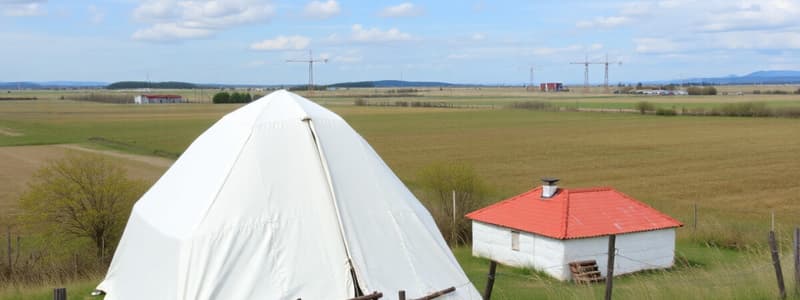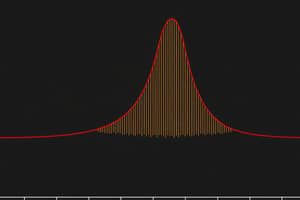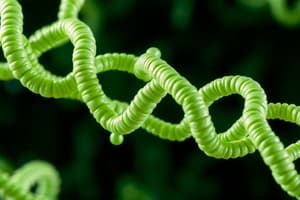Podcast
Questions and Answers
Which characteristic of the peptide bond most directly restricts the possible conformations of a polypeptide chain?
Which characteristic of the peptide bond most directly restricts the possible conformations of a polypeptide chain?
- Its ability to form hydrogen bonds with water molecules.
- Its flexibility, allowing free rotation around the bond.
- Its partial double-bond character, which prevents rotation. (correct)
- Its positive charge, which repels other amino acids.
What is the 'native conformation' of a protein primarily determined by?
What is the 'native conformation' of a protein primarily determined by?
- The number of disulphide bridges.
- The linear sequence of amino acids. (correct)
- The presence of prosthetic groups.
- External factors such as temperature and pressure.
Which level of protein structure is defined by the sequence of amino acids?
Which level of protein structure is defined by the sequence of amino acids?
- Secondary structure
- Tertiary structure
- Quaternary structure
- Primary structure (correct)
Steric hindrance between which groups favors the trans conformation of peptide bonds?
Steric hindrance between which groups favors the trans conformation of peptide bonds?
What is the significance of the active site in an enzyme's function?
What is the significance of the active site in an enzyme's function?
How does the partial double bond character of a peptide bond influence its properties?
How does the partial double bond character of a peptide bond influence its properties?
Rotation around which bonds influence a protein's conformation?
Rotation around which bonds influence a protein's conformation?
If a mutation in a gene alters the primary structure of an enzyme, what is the most likely direct consequence?
If a mutation in a gene alters the primary structure of an enzyme, what is the most likely direct consequence?
Which of the following interactions is the MOST significant contributor to stabilizing a protein's tertiary structure under physiological conditions?
Which of the following interactions is the MOST significant contributor to stabilizing a protein's tertiary structure under physiological conditions?
What is the MOST likely effect of a significant increase in temperature on an enzyme's function?
What is the MOST likely effect of a significant increase in temperature on an enzyme's function?
What is the PRIMARY role of disulfide bonds in protein structure?
What is the PRIMARY role of disulfide bonds in protein structure?
A protein is secreted from a cell into a harsh extracellular environment. Which type of structural stabilization would MOST likely be crucial for its function?
A protein is secreted from a cell into a harsh extracellular environment. Which type of structural stabilization would MOST likely be crucial for its function?
An enzyme exhibits optimal activity at pH 7.4. What is the MOST probable reason for its decreased activity at pH 2.0?
An enzyme exhibits optimal activity at pH 7.4. What is the MOST probable reason for its decreased activity at pH 2.0?
Hemoglobin is composed of two alpha subunits and two beta subunits. What level of protein structure does this describe?
Hemoglobin is composed of two alpha subunits and two beta subunits. What level of protein structure does this describe?
If a mutation occurs in a gene coding for an enzyme, and the mutant enzyme is unable to bind its substrate effectively, which level of protein structure is MOST likely affected?
If a mutation occurs in a gene coding for an enzyme, and the mutant enzyme is unable to bind its substrate effectively, which level of protein structure is MOST likely affected?
What is the impact of heat on the native conformation of an enzyme during a chemical reaction in a laboratory?
What is the impact of heat on the native conformation of an enzyme during a chemical reaction in a laboratory?
What primarily restricts the rotation around bonds in a polypeptide chain, influencing its folding?
What primarily restricts the rotation around bonds in a polypeptide chain, influencing its folding?
What defines the secondary structure of a protein?
What defines the secondary structure of a protein?
What are the approximate torsion angle values (phi and psi) that are characteristic of an -helix?
What are the approximate torsion angle values (phi and psi) that are characteristic of an -helix?
How many amino acid residues are required for one complete turn of an -helix?
How many amino acid residues are required for one complete turn of an -helix?
Which interaction stabilizes the -helix secondary structure?
Which interaction stabilizes the -helix secondary structure?
Where are the side chains located in an -helix?
Where are the side chains located in an -helix?
What structural feature is commonly found in the transmembrane domains of receptor proteins?
What structural feature is commonly found in the transmembrane domains of receptor proteins?
Which statement accurately differentiates between parallel and antiparallel $\beta$ sheets?
Which statement accurately differentiates between parallel and antiparallel $\beta$ sheets?
Why is understanding the structure of transmembrane domains important in pharmacology?
Why is understanding the structure of transmembrane domains important in pharmacology?
What primarily stabilizes the $\beta$ sheet secondary structure?
What primarily stabilizes the $\beta$ sheet secondary structure?
What role do hydrophobic interactions play in stabilizing $\beta$ sheets?
What role do hydrophobic interactions play in stabilizing $\beta$ sheets?
Fibrous proteins are characterized by which of the following?
Fibrous proteins are characterized by which of the following?
Which of the following properties is NOT typical of fibrous proteins?
Which of the following properties is NOT typical of fibrous proteins?
What structural level is defined as the three-dimensional arrangement of secondary structure elements in a protein?
What structural level is defined as the three-dimensional arrangement of secondary structure elements in a protein?
Hair is primarily composed of $\alpha$-keratin. Which of the following best describes the structure of $\alpha$-keratin?
Hair is primarily composed of $\alpha$-keratin. Which of the following best describes the structure of $\alpha$-keratin?
Collagen, found in chicken cartilage, is characterized by what type of secondary structure arrangement?
Collagen, found in chicken cartilage, is characterized by what type of secondary structure arrangement?
Which statement best describes the arrangement of amino acid side chains in a globular protein in an aqueous solution?
Which statement best describes the arrangement of amino acid side chains in a globular protein in an aqueous solution?
What is the primary driving force behind the stabilization of a protein's tertiary structure through the hydrophobic effect?
What is the primary driving force behind the stabilization of a protein's tertiary structure through the hydrophobic effect?
How does the compact, roughly spherical shape of globular proteins contribute to their function?
How does the compact, roughly spherical shape of globular proteins contribute to their function?
Which of the following amino acids would most likely be found in the interior of a water-soluble globular protein?
Which of the following amino acids would most likely be found in the interior of a water-soluble globular protein?
What role do hydrogen bonds and electrostatic interactions play in stabilizing the tertiary structure of proteins?
What role do hydrogen bonds and electrostatic interactions play in stabilizing the tertiary structure of proteins?
An octapeptide has the following sequence: Ser-Leu-Ala-Phe-Asp-Ala-Val-Thr. Based on the properties of amino acid side chains, which folding pattern is most likely to occur?
An octapeptide has the following sequence: Ser-Leu-Ala-Phe-Asp-Ala-Val-Thr. Based on the properties of amino acid side chains, which folding pattern is most likely to occur?
What is the significance of enzymes being water-soluble globular proteins?
What is the significance of enzymes being water-soluble globular proteins?
How does efficient packing of amino acid residues contribute to the stability of a protein's tertiary structure?
How does efficient packing of amino acid residues contribute to the stability of a protein's tertiary structure?
Flashcards
Primary (1º) Structure
Primary (1º) Structure
The linear sequence of amino acids in a protein.
Native Conformation
Native Conformation
The biologically active, folded shape of a protein.
Active Site
Active Site
Region on an enzyme that recognizes and binds to substrate molecules.
Peptide Bond
Peptide Bond
Signup and view all the flashcards
Planar and Rigid
Planar and Rigid
Signup and view all the flashcards
Trans Conformation
Trans Conformation
Signup and view all the flashcards
Phi (Φ) Torsion Angle
Phi (Φ) Torsion Angle
Signup and view all the flashcards
Psi (Ψ) Torsion Angle
Psi (Ψ) Torsion Angle
Signup and view all the flashcards
Steric Hindrance
Steric Hindrance
Signup and view all the flashcards
Secondary Structure
Secondary Structure
Signup and view all the flashcards
Alpha-Helix
Alpha-Helix
Signup and view all the flashcards
Phi and Psi Angles
Phi and Psi Angles
Signup and view all the flashcards
Residues per Turn
Residues per Turn
Signup and view all the flashcards
Hydrogen Bonds in Helix
Hydrogen Bonds in Helix
Signup and view all the flashcards
Transmembrane Domain
Transmembrane Domain
Signup and view all the flashcards
Beta Sheet
Beta Sheet
Signup and view all the flashcards
Antiparallel Beta Sheet
Antiparallel Beta Sheet
Signup and view all the flashcards
Parallel Beta Sheet
Parallel Beta Sheet
Signup and view all the flashcards
Fibrous Proteins
Fibrous Proteins
Signup and view all the flashcards
Collagen
Collagen
Signup and view all the flashcards
Alpha-Keratin
Alpha-Keratin
Signup and view all the flashcards
Tertiary Protein Structure
Tertiary Protein Structure
Signup and view all the flashcards
Tertiary Protein Examples
Tertiary Protein Examples
Signup and view all the flashcards
Globular Proteins
Globular Proteins
Signup and view all the flashcards
Properties of Globular Proteins
Properties of Globular Proteins
Signup and view all the flashcards
Globular Protein Structure
Globular Protein Structure
Signup and view all the flashcards
Hydrophobic Effect
Hydrophobic Effect
Signup and view all the flashcards
Protein Folding and Polarity
Protein Folding and Polarity
Signup and view all the flashcards
Packing Effects on Tertiary Structure
Packing Effects on Tertiary Structure
Signup and view all the flashcards
Hydrogen Bonding in Proteins
Hydrogen Bonding in Proteins
Signup and view all the flashcards
Protein Folding Purpose
Protein Folding Purpose
Signup and view all the flashcards
Disulfide Bonds
Disulfide Bonds
Signup and view all the flashcards
Temperature/pH Effects on Enzymes
Temperature/pH Effects on Enzymes
Signup and view all the flashcards
Protein Denaturation
Protein Denaturation
Signup and view all the flashcards
Optimal Enzyme Conditions
Optimal Enzyme Conditions
Signup and view all the flashcards
Quaternary Structure
Quaternary Structure
Signup and view all the flashcards
Hemoglobin Structure
Hemoglobin Structure
Signup and view all the flashcards
Study Notes
- Proteins are large molecules composed of several hundred amino acids
- Artificial intelligence has largely solved one of biology's biggest mysteries in protein structures
- Predicting how a protein folds into a unique three-dimensional shape has puzzled scientists for half a century
- A better understanding of protein shapes could play a pivotal role in the development of novel drugs to treat disease
Primary Structure
- The linear sequence of amino acids in a peptide is called the primary (1°) structure of the protein
Native Conformation
- A polypeptide chain is not linear and folds into a biologically active shape
- The biologically active form of a polypeptide chain is known as its native conformation
Enzyme Active Sites
- Biological functions of many proteins can be explained by their conformations or shapes
- An enzyme folds to form an active site that can recognize substrate molecules.
The Peptide Bond
- Properties of the peptide bond have considerable impact on the shape and function of proteins
- The peptide bond is planar and electron resonance gives it 40% double bond character
- It can be regarded as the average of two extreme resonance forms
- Some properties are a result of its double bond character, making it rigid and planar
- Rotation around the peptide bond is not possible
Peptide Bond Conformation
- Peptide bonds have a trans conformation
- Steric hindrance between side chain groups favors the trans conformation
- Since the peptide bond is rigid, only two free movements exist in a polypeptide chain
- Rotation about the αC-N bond is called the phi (Φ) torsion angle
- Rotation about the αC-C bond is called the psi (Ψ) torsion angle
Bonds and Conformation Restrictions
- Protein conformation depends on phi (Φ) and psi (Ψ) rotations
- Flexibility of these bonds allows the primary sequence to fold into its native conformation
- Rotation is limited by steric hindrance, where bulky groups cannot approach each other
- The rigidity of the peptide bond ultimately restricts movement
- Favorable interactions, like hydrogen bonds, with other regions of the polypeptide chain also limit rotation
Secondary Structure: Alpha-Helix
- Secondary (2°) protein structure is defined as 'the three dimensional arrangement of the primary amino acid sequence.'
- The α-helix results when consecutive amino acid residues have similar phi (Φ) and psi (Ψ) torsion angle values
- phi (Φ) = —57°, psi (Ψ) = —47°
- Alpha-helix is a SINGLE helix, not to be confused with DNA
- 3.6 amino acid residues are required for one complete turn of the helix
- Each backbone carbonyl oxygen is hydrogen bonded to the peptide nitrogen of the fourth residue along (towards C terminus), stabilizing the helix
- Hydrogen bonds are weak but hold the helix structure together
- Side chains are arranged on the outside of the helix.
Alpha-Helix Rich Proteins
- Receptors are proteins rich in alpha-helices with a trans-membrane domain composed entirely of alpha-helices
- An example of one is the crystal structure of the Adenosine Receptor in cardiac tissue
- Adenosine, a treatment for supraventricular tachycardia, binds to the trans-membrane domain
Secondary Structure: Beta-Sheet
- A beta-sheet is a secondary protein structure where strands of the peptide backbone are hydrogen bonded to themselves
- The beta-sheet is an elongated, reasonably flat 'sheet-like' structure
- Inter-strand hydrogen bonds between backbone carbonyl oxygen and amide nitrogens stabilize the beta-sheet
- Side chain interactions (hydrophobic) can provide additional stabilization
Types of Beta-Sheets
- Antiparallel beta-sheets are optimally hydrogen bonded, with linear hydrogen bonds
- These have better overlap and are stronger, with 2–15 strands possible (average 6)
- Parallel beta-sheets have distorted hydrogen bonds and are less stable
- Parallel beta-sheets have no more than 5 strands encountered
Fibrous Proteins
- Fibrous proteins contain only alpha-helix secondary protein structure with a simple, elongated structure
- Provide mechanical support in skin, tendons, and bones and are physically durable, chemically inert, and water-insoluble
- Structure is maintained by hydrogen bonding within the alpha-helix
- Hair is composed mostly of alpha-keratin, a double coil of alpha-helices
- Many double coils are packed together to form a strand of hair
- Collagen from chicken cartilage is a triple coil of alpha-helices
Tertiary Structure
- Tertiary (3°) protein structure is the three-dimensional (spatial) arrangement of secondary structure
- Tertiary proteins, like enzymes, often contain an assortment of secondary features
- Receptors also have tertiary structure and trans-membrane domain attached to a cytoplasmic domain.
- The precise structure of membrane-bound receptors is difficult to determine
Globular Proteins
- Globular proteins are tertiary proteins with greater structural diversity
- All enzymes are globular proteins with a unique and complex structure
- Are water-soluble, compact, roughly spherical, with tightly folded peptide chains
- Exhibit a hydrophobic interior and hydrophilic surface, maintained by covalent and hydrogen bonding, non-covalent crosslinks, and hydrophobic interactions
- They possess indents or clefts, forming an active site
- Enzymes function by binding to a protease enzyme (e.g., trypsin)
- It is not as obvious how the tertiary structure of an enzyme is responsible for its properties
Stabilization of Tertiary Structure
- Proteins are more stable in water due to hydrophobic side chains tucked into the protein interior
- Non-polar substances minimize contact with water, causing non-polar chains to aggregate and fold the protein
- Non-polar side chains aggregate to the inside and polar sidechains at the outside
- Efficient packing maximizes van der Waals interactions between non-polar residues and excludes water from the interior
- Enzymes must be water-soluble and the amino acids Val, Leu, Ile, Met, Phe and Ala are rarely encountered on protein exteriors
- Proteins are arranged to form all possible hydrogen bonds
- Polar side chains forced into the protein interior neutralize their polarity by forming hydrogen or electrostatic bonds
- Folding maximizes hydrogen, hydrophobic non-covalent and covalent interactions, stabilizing protein
Covalent Bonds
- Disulfide bonds are cross links between adjacent cysteine residues and stabilize conformations of some proteins
- A covalent bond is stronger than a hydrogen bond or van der Waals forces
- Disulfide links are especially common in proteins secreted from cell
Temperature and pH Effects
- Heating a chemical reaction increases its rate, but enzymes function poorly at extremes of temperature or pH
- The tertiary structure of an enzyme is responsible for biological activity and maintained by weak interactions (hydrogen bonds and van der Waals forces)
- Changes to pH or temperature disrupt the stabilising interactions, causing changes to the tertiary structure.
- This causes the protein to be denatured
- Enzymes have evolved to function (maximum stabilization of tertiary structure) at physiological conditions of pH 7.4 and 37 °C.
Quaternary Structure
- Quaternary (4°) structure refers to proteins composed of more than one polypeptide strand
- Haemoglobin is composed of 4 globular protein subunits: two identical 'a units' with 141 amino acids and two identical 'ẞ units' with 146 amino acids
- Each subunit contains an iron atom, vital for oxygen transport in the blood
- Insulin, a hormone that controls glucose metabolism, has two peptide chains, linked and maintained in the biological active conformation by three disulfide bridges.
Obtaining Protein Structures
- Through X-ray crystallography or Cryogenic electron microscopy
Studying That Suits You
Use AI to generate personalized quizzes and flashcards to suit your learning preferences.




